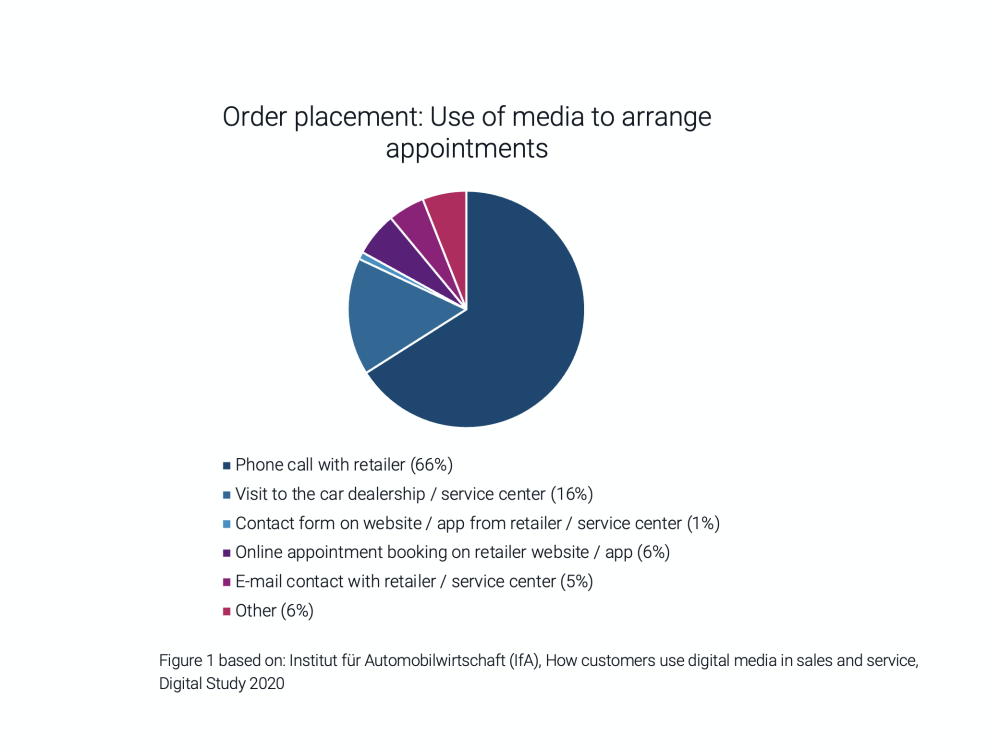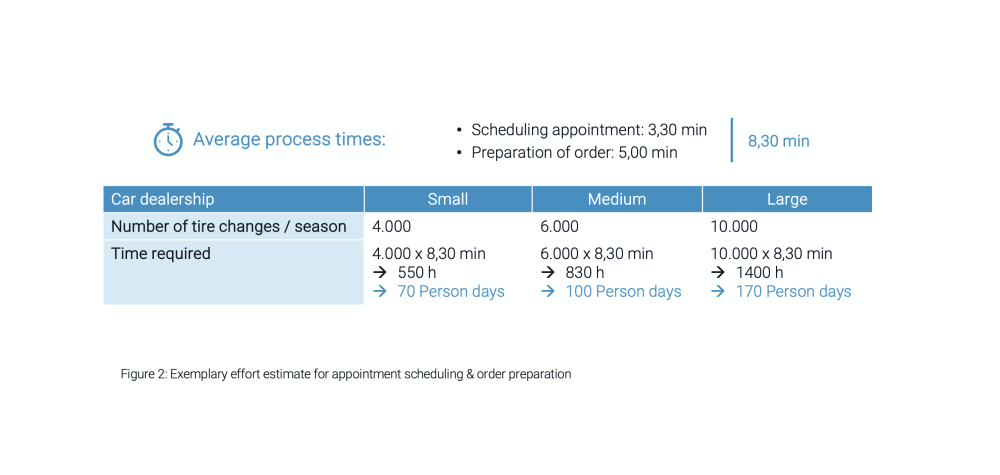
Solutions for partial automation of the core service process in car dealerships
Starting situation
The seasonal tire change poses recurring challenges for car dealerships. On one hand, businesses are aware of the additional cross-selling and upselling potentials that arise from these extra interactions with customers. On the other hand, during this period, it's often not feasible to systematically and focus on tapping into these potentials due to various reasons, including customer communication preferences and labor-intensive, time-consuming processes.
Despite the advancing digitization of the service process, customers still prefer traditional communication channels. The phone call to the car dealership remains a primary means of communication with the service partner. Consequently, there is a seasonal overload of staff in order acceptance and poor telephone accessibility for the business. To address this accessibility issue, dealerships cope with the increased call volume by deploying additional staff.

The tight staffing situation during the tire season is exacerbated by complex and time-consuming processes in order preparation. A complete and seamless order preparation is essential for optimal customer readiness. This involves a combination of in-house dealership systems, manufacturer-prescribed IT systems, and external partner-provided systems. Rarely is there a direct and automated data transfer between these systems. The absence of interfaces results in additional manual efforts and duplicate data entry, significantly impacting process time.

As the above graphic illustrates, the average personnel efforts for telephone appointment scheduling and order preparation can accumulate to 70 or more person-days, depending on the size of the operation. This immense time investment typically has a noticeable negative impact on overall business activities and employee and customer satisfaction. Consequences may include:
- Overloading of involved staff due to sporadically high order volumes
- Realization of generally lower contribution margins due to high personnel expenses and low revenue per wheel change
- Unrecognized cross- and upselling potential due to overload and lack of time for consultation
- Increased occurrence of customer complaints, partly due to poor telephone accessibility of the business
To counteract these negative consequences and provide businesses with more flexibility for their other operations during the tire change season, rpc - The Retail Performance Company, has developed an automation solution. This solution can be implemented independently of the dealer's existing system environment. It enhances the Voicebot technology with subsequent automation of data processing through Robotic Process Automation (RPA). The synergy between these technologies will be further explained below.
Optimization of the seasonal tire change through partial automation
Partial Solution 1: Implementation of Voicebot
The typical customer conversation for appointment scheduling generally follows a relatively standardized framework. In addition to finding a suitable date for the tire change, a few personal and vehicle-related details need to be collected. This relatively low level of individualization provides the opportunity for the (seasonal) use of a "Voicebot." The Voicebot conducts the customer conversation and automates appointment and data matching. No manual efforts are required from an employee. Procedurally, at the beginning of the call, the customer is given the option to choose whether they are calling for an upcoming tire change or have another inquiry. In the latter case, they are connected to an employee as usual.
Partial Solution 2: Implementation of Robotic Process Automation (RPA)
To further reduce the subsequent manual efforts in order preparation, an automation of data transfer is targeted at various system interfaces. This is where the "Robotic Process Automation (RPA)" comes into play. RPA involves the use of a software robot triggered by predefined triggers to automate previously manual tasks, such as transferring master data. The deployment of an RPA bot is independent of the existing system ecosystem and its interface compatibility. Moreover, existing process workflows are not altered.
These two partial solutions enable the generation of significant long-term personnel cost savings with relatively low implementation effort. The magnitude of the savings is illustrated in Figure 2. It is worth noting that these efficiency gains can be achieved without deeply interfering with the existing system environment.
Outlook
The presented example of scheduling tire change appointments is just one of many applications for these technologies. Many other repetitive but time-intensive customer interactions and processes can be automated using this solution. Our experts are here to assist in assessing the potential benefits. Additionally, we will consistently identify further levers for efficiency improvement and enhancing the customer experience quality in the automotive industry, presenting innovative digital solutions. Follow us on our online channels to stay updated and not miss any publication!








